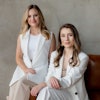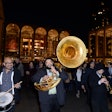It might be said that 2009 is a year that created a particular need for inspiration and community support—especially in a state like California, where budget shortfalls and the unemployment rate have become notorious. Either in spite of or because of that climate, California's first lady, Maria Shriver, and Governor Arnold Schwarzenegger's Women's Conference once again drew masses of women from all over the state to join a packed roster of about 70 high-level speakers and participants at the Long Beach Convention Center.
This year, the program ballooned from a single day to two full days—to accommodate the increasing number of would-be attendees. (Each year, full-day passes to the conference sell out in record time. Tickets this year sold out in less than two hours, beating last year's record of three.) The first day's program, a Day of Transformation, served as somewhat more informal programming, with two 1,500-attendee sessions and six 400-person breakout sessions. "We were getting so much feedback from people who wanted to participate and have access," said executive producer Alexandra Gleysteen. "It's a way to get more hands-on information—how to get a new job, start a nonprofit—all in a spiritual context and a serene environment. It's on a different scale, more intimate, than the main program."
On the evening of the first day, the Night at the Village portion, added in 2008, filled the convention center’s exhibit hall with 160,000 square feet of exhibitors (from retailers to message-based booths) and programming. Hall carpeting was done in jewel tones—on-message with the conference's purple, orange, and green logo. Town & Country created a luxe lounge area in the center of the hall—known as the village square. And throughout the exhibit hall, jewel-toned lanterns (the same ones used to decorate the colorful Emmy Governors Ball) hung overhead.
The event featured stage conversations with prominent speakers; book signings with more than 25 best-selling authors; presentations on topics like food, health and wellness, and the environment; and live music and dancing. The village stayed open throughout the conference the following day.
New sold-out events increased attendee capacity by 11,000 tickets, bringing the total attendance to 25,000. Also new for this year was a step-and-repeat wall for media outlets to capture the action. And to accommodate even more viewers, the conference's main event also streamed live on its Web site.
Conference executive director Erin Mulcahy Stein worked with Gleysteen for the TV production element, Julia Paige for the Night at the Village, Karen Skelton at Dewey Square for speaker coordination, and Carl Bendix at Ambrosia, who handled the overall production and coordination, and who has worked on events for the Schwarzenegger-Shriver family for more than 25 years.
About 500 staffers were on hand this week for the event, which began loading in last Friday, and the longer conference required that the team had to be "much tighter about pre-production throughout," Bendix said.
Program highlights from Tuesday included stage conversations and 12 breakout conversations. Robin Roberts moderated a main stage conversation on leadership decisions in tough times with the governor, F.D.I.C. chairwoman Sheila C. Bair, and Richard Branson. Katie Couric conducted a discussion with Annie Leibovitz. And Maria Shriver lead a main stage panel on grief, healing, and resilience with Elizabeth Edwards, Susan Saint James, and Lisa Niemi.
At the end of the second day, the Women's Conference presented its annual Minerva Awards, honoring women it deems remarkable. Shriver hosted the ceremony, held during the afternoon main stage session, where illuminated set pieces in a curvilinear fin motif flanked the stage. The awards included remarks by Pulitzer Prize-winning journalist Nicholas Kristof, Alicia Keys, and Caroline Kennedy. In order to keep the program running quickly and seamlessly, a motorized second stage behind the main stage moved forward for Keys's performance.
As to the look and feel of the day, Bendix added, "It's all about substance and style. It's a cause-driven, issue-driven event. But it also gets its [signature look] through color, lighting, sound, style." The annual event is produced by the California Governor & First Lady's Conference on Women, a nonprofit, nonpartisan organization. Proceeds support the conference's six programs, known as We.





























